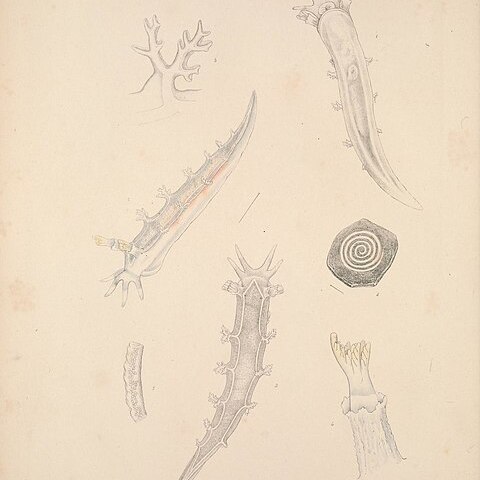Herb 30–60 cm high. Corm to 2 cm diam.; tunic of netted fibres forming a distinct neck. Leaves 4–8, linear-lanceolate, 7–30 cm long, 7–18 mm wide, rather soft-textured with 3–5 pale prominent veins. Spike slightly flexuose, 7–15-flowered. Bracts oblong, 8–12 mm long, scarious, dark brown. Flowers zygomorphic, funnel-shaped, cream, finely dark-veined. Perianth tube 1–1.5 cm long, expanded evenly from base; lobes oblong to oblanceolate, 1.5–2.5 cm long, straight with spreading apices; dorsal lobe wider than others. Stamens unilateral; filaments curved, c. 10 mm long; anthers 7–9 mm long, yellow. Ovary globose, c. 3 mm diam.; style exceeding stamens; branches filiform to cuneate, c. 4 mm long. [See also Green (1994: 520), as Tritonia lineata.]
Perennial herb, geophyte, 0.15-0.60 m high; corm globose, tunics of finely netted fibres; stem simple or 1-branched. Leaves ensiform to lanceolate, erect to spreading, with prominent vein near each margin, 5-10 mm wide. Bracts membranous, brown above. Inflorescence a secund, lax spike; cream-coloured or yellow, with dark veins, slightly zygomorphic; perianth tube 10-15 mm long, funnel-shaped; tepals 15-20 mm long, subequal, obovate-lanceolate, dorsal erect, lower with thickened median ridge. Stamens curved; filaments 7-12 mm long; anthers unilateral, pale or dark striped; pollen cream-coloured. Style curved. Flowering time Aug.-Nov.
Cormous geophyte to 60 cm. Leaves sword-shaped with prominent submarginal veins. Flowers weakly bilabiate, pale yellow, occasionally orange with dark veins, lower tepals or only lower median tepal with thickened longitudinal ridges.

